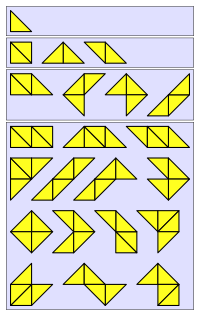Polyabolo
Polyaboloes were introduced by Martin Gardner in his June 1967 "Mathematical Games column" in Scientific American.
The name polytan is derived from Henri Picciotto's name tetratan and alludes to the ancient Chinese amusement of tangrams.
Similarly, the order of a polyabolo P can be defined as the minimum number of congruent copies of P that can be assembled (allowing translation, rotation, and reflection) to form a rectangle.
One such is the tetrakis square tiling, a monohedral tessellation that fills the entire Euclidean plane with 45–45–90 triangles.
Systematic results first appeared in 2004 on Erich Friedman's website Math Magic.



